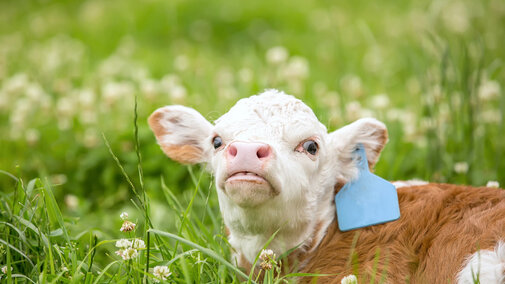Legume Frost Seeding in Pastures
By Brad Schick
Are you looking to increase production from pastures or hay fields? Interseeding legumes might just work in your operation.
Nitrogen is one of the key ingredients for productive pastures. A way to get more nitrogen in a pasture is to plant legumes. Alfalfa, birdsfoot trefoil, clovers and other legumes all fix atmospheric nitrogen and can reduce nitrogen costs. These legumes are also very high in forage quality.
Not all pastures are good candidates for adding legumes, however. First, legumes need adequate phosphorus and a pH usually above six, while some prefer a pH closer to seven. Next, good seed placement is needed. When interseeding with a no-till drill is not an option due to frozen ground or topography, frost seeding is an option to consider. Frost seeding uses broadcasting seed in winter to allow the natural freezing and thawing of the ground to plant the seed for you, resulting in good seed to soil contact. Frost seeding success can vary and while more invasive, drilling is almost always a better option if the pasture would allow it. Because frost seeding requires seed to be close to the soil surface after broadcasting, snow-free or very little snow is preferred.
Lastly, heavy flash grazing several times in the spring will reduce the competition from existing grasses and help promote the legume seedlings. Once the grass is three to four inches taller than the seedlings, graze quickly until the grasses are grazed down to the height of the legume seedlings.
Legumes can help reduce fertilizer cost and create higher quality pastures and hay. Frost seeding is an economical approach that might work to establish legumes in your operation.
Spring Planting Alfalfa
Alfalfa can be successfully seeded in the spring or fall depending on field weed populations, moisture conditions and timing. Based on higher snowfall, our 2023 spring may be a very successful time to establish new alfalfa stands.
Although it may be tempting to drill or broadcast more seeds into open spaces in thin alfalfa fields, remember that live alfalfa roots emit an ethylene chemical toxin which impedes new alfalfa growth. This “autotoxicity” weakens or kills any new alfalfa plants and accumulates in soil over time. Therefore, it is better to drill into new fields than seed where previous older alfalfa plants have been grown within the past one to two years.
Once established, alfalfa as a perennial can complete well with weeds. If herbicide-resistant weeds are currently growing on fields, then light tillage may be needed to control weeds while creating a firm drilling seedbed. Also, combination light tillage plus herbicide may provide improved seedling establishment. Since new alfalfa seedlings are very susceptible to herbicide injury, carefully follow any chemical label restrictions. Usually, new alfalfa plants must reach two to four trifoliated leaf development before herbicides are applied; note that 2,4-D usage is not recommended.
Glyphosate-tolerant or Round-up Ready varieties provide more flexibility for controlling weeds currently growing in fields. Initial glyphosate application should occur between alfalfa emergence and fourth trifoliate leaf growth stages to remove non-glyphosate-tolerant alfalfa seedlings and control weeds that are present.
Target seeding ¼ to ½ inch depth in the fine-textured soils and ¾ inch depth in sandy soils. Seedlings placed too shallow will dry out rapidly and die due to poor roots, while seeds planted more than one inch deep may be unable to emerge after germinating. Further establishment guidelines are outlined in the UNL “Seeding Alfalfa” NebGuide G2247.

